If someone says, “tropical paradise,” do you immediately think of white sand beaches, crystal blue seas, palm trees swaying in a gentle breeze, and perhaps a thatch-roofed hut? You have just imagined the reality that is San Blas, an archipelago of 365 islands that is home to the Guna, an indigenous and fiercely independent group of people with culture and traditions unique to their rich environment.
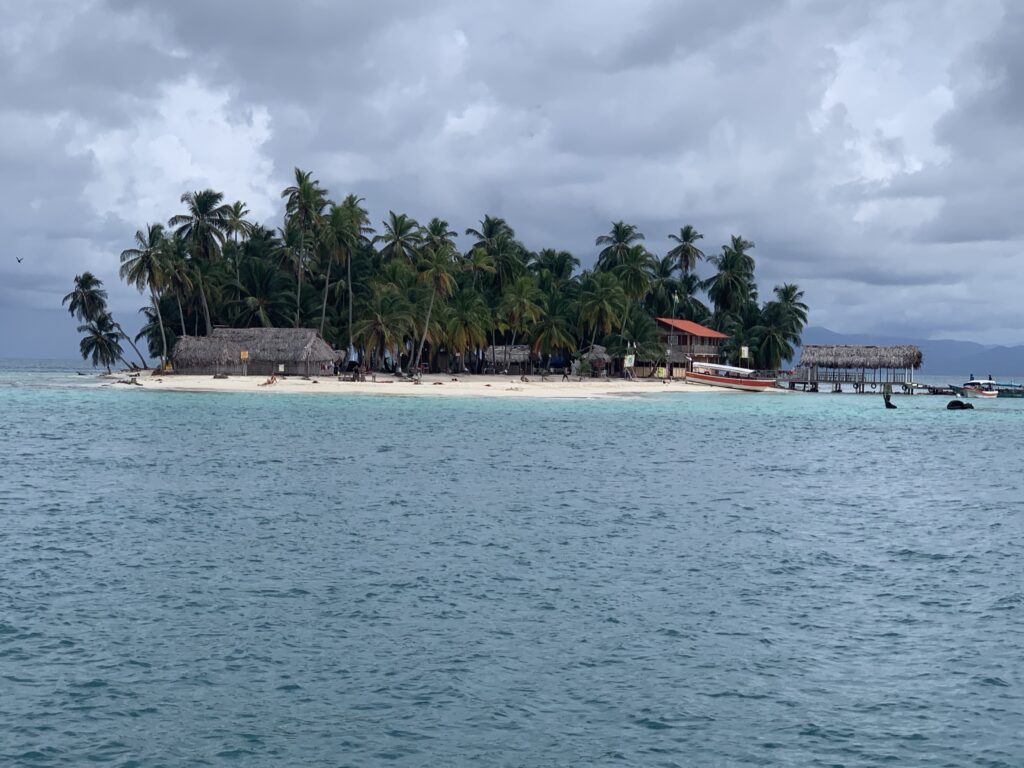
With our friends from Spanish class, Heidi and Simon, we spent three days and two nights exploring the islands, eating delicious fresh food, snorkeling, meeting interesting people, laughing, and relaxing on the beach.
A note on photos: Simon airdropped all of his iPhone photos to me, and my little MacBook Pro mixed up his and mine based on date and time, not photographer. Some are labeled with credit, but generally, if they are beautiful and artistic, they are Simon’s photos. If they are adequate and illustrative, they are mine.
Pre-Getting There: As with all things Panamanian, you’ll find a lot of information on the internet that is outdated. Our recommendation is to go through one of the few tour companies that work directly with the Guna folks. We used a hostel just down the street from us with the internet moniker of San Blas Dreams, https://www.sanblasdreams.com/. One aspect of the website that we particularly liked was this note: “If you are an intransigent or demanding person with schedules or if you are looking for a 5 stars service, this tour is not for you, but if you wish to enjoy extraordinary beaches in the Caribbean then we invite you to book with us.” We booked with them.
Getting There: Our ride, a 4-wheel drive Toyota Prada decked out in mountain (not jungle) camouflage, arrived for pick up at 5:50 a.m. Our driver was Teo, who probably speaks more English than he pretends to, and who knows how to negotiate Panama City traffic and Panama jungle potholes with aplomb. We piled in, picked up a couple of more passengers at another hotel, made a quick grocery store stop for drinks and snacks, and were off to adventure. We headed east into a stunning sunrise on the Pan American Highway, driving along with quite a bit of traffic for just over an hour and then made an abrupt turn to the north with only other SUVs for traffic. We traversed incredibly steep hillsides, plunged into verdant valleys, and watched clouds be born in the cloud forest. The road was nothing short of horrendous, with potholes that could swallow small cars and do major damage to the stoutest SUV. Teo knows most of the potholes by name, though, and got us through it without any seriously jarred or broken teeth.
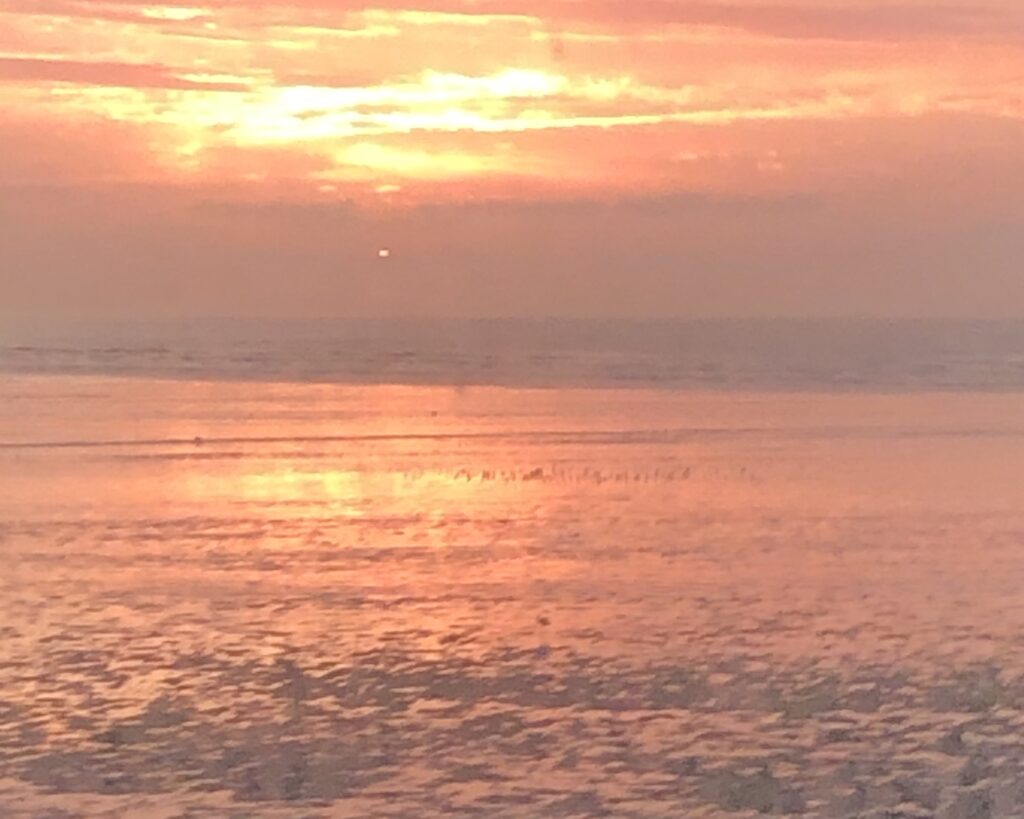
About halfway along the road, we stopped and showed our passports to several guards. Passing through the gate, we entered the Guna Yala comarca, what we in the states would call a reservation. The road remained terrible, but our anticipation grew.
Unfortunately, clouds covered the mountain peak that provides the overlook to the Caribbean, so we didn’t get that spectacular view. We did, however, see flowering trees and plants in between the bumps. It was still a beautiful drive.
After about an hour on this road of 30 kilometers (mas o menos), we arrived at Puerto de Carti, a ramshackle conglomeration of buildings and docks, where Teo handed us over to El Capitan, the man who would take us in his boat to the island and for our tours. The boat, Kuna Sea Express, painted with a shark mouth, was barebones yet seaworthy. We would have rather used our lifejackets as seat cushions, but that was not allowed.

Teo after paying our $2 per person port tax 
Puerto de Carti
The ride out to Devil’s Island was as rough as the road. For several weeks the Caribbean coast of Panama has had unusually rainy and windy weather, and we felt the effects as El Capitan slammed every swell he came across. Since he had a big grin on his face the whole time, I’m sure he thought it was part of the adventure for all the gringos. Again, no one lost any teeth, but visits to the chiropractor are probably in order for us all!
We arrived safely to a site on Devil’s Island dubbed Naidub Cabanas and were immediately asked what we wanted for lunch (more on that below). Then we were shown to our rustic cabin (also more below), and were free to hang out on the beach for the rest of the afternoon.
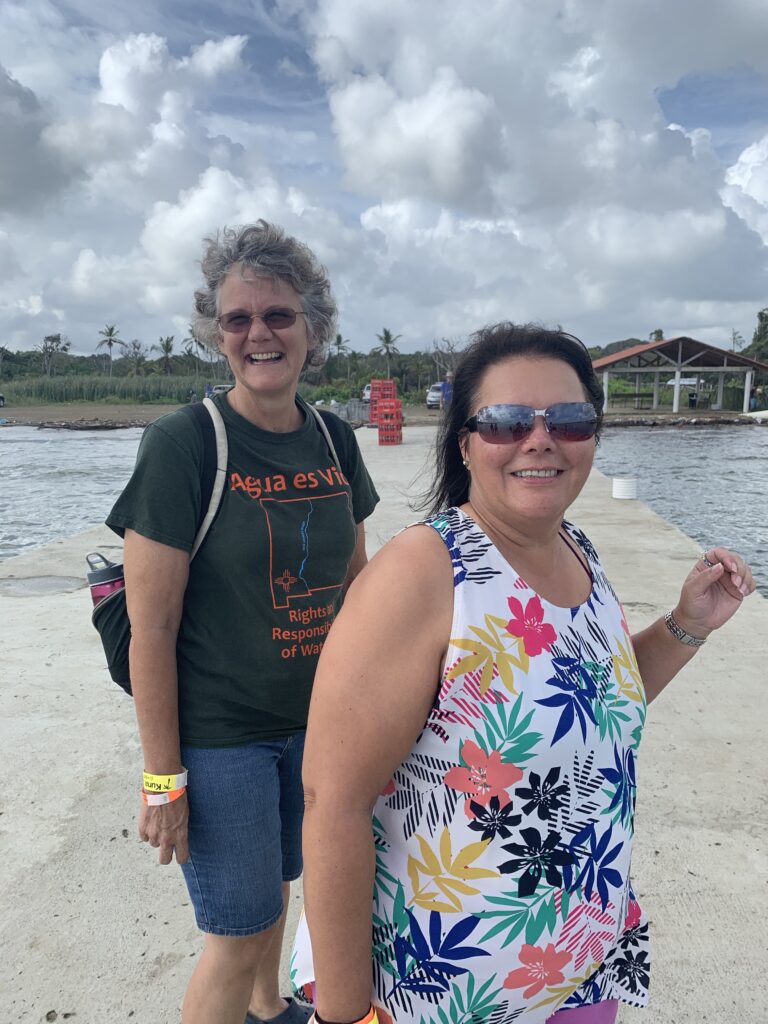
Heidi and I ready to board 
Crammed in like sardines 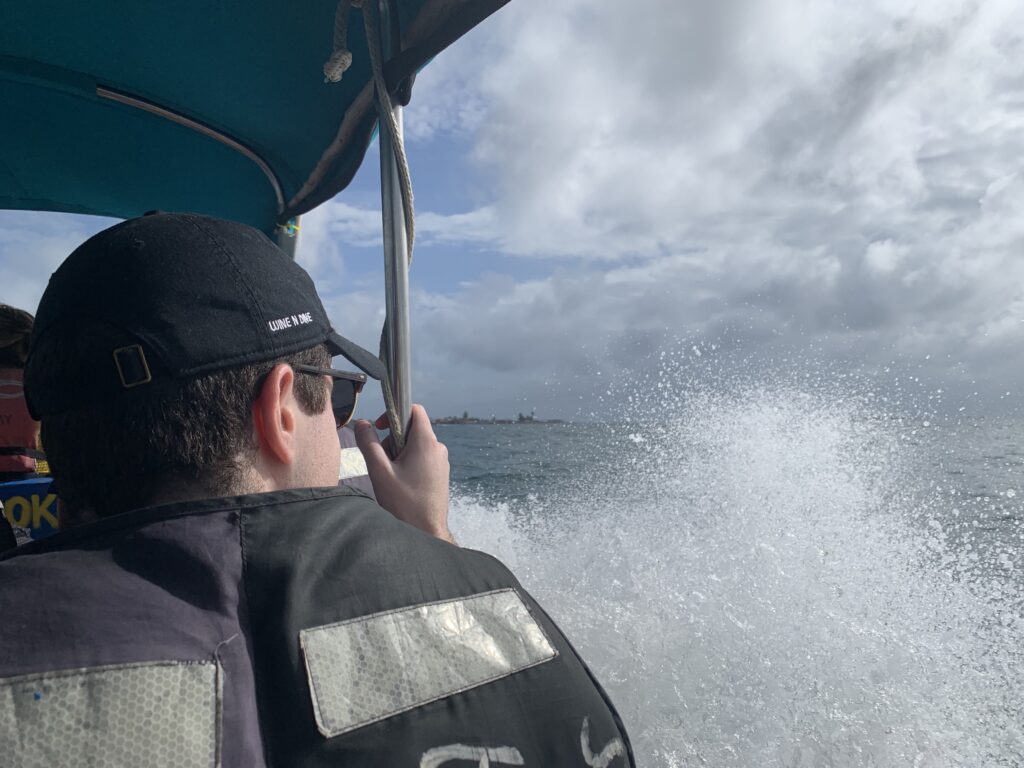
Rough ride! 
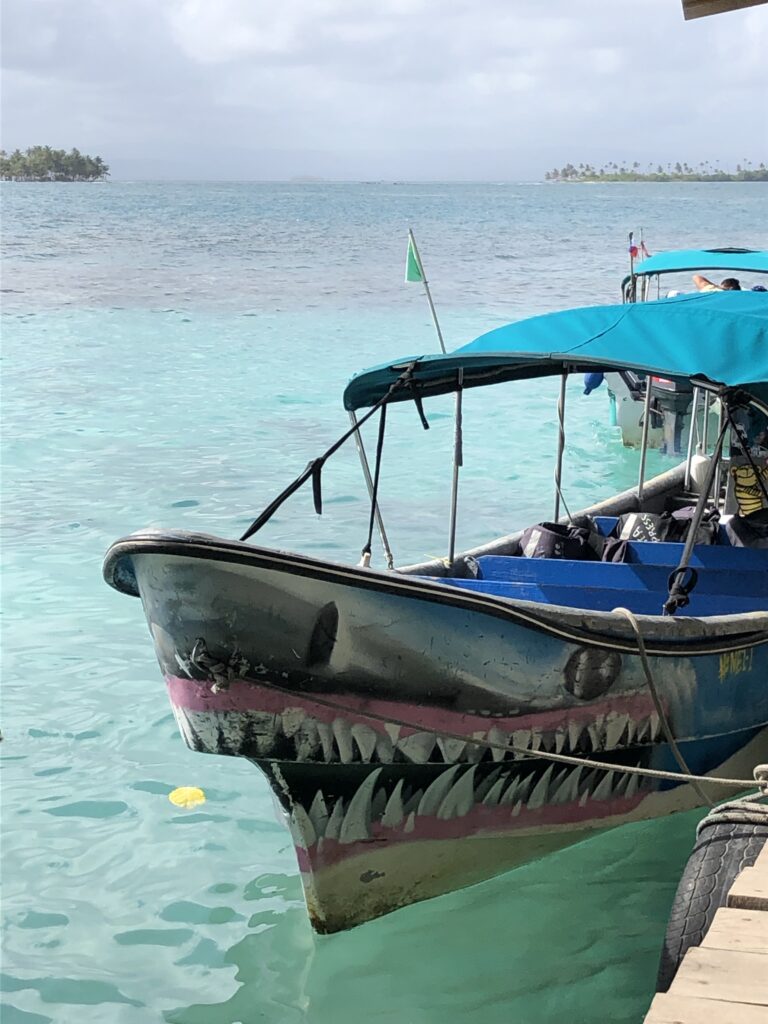

The pier and dining “room”
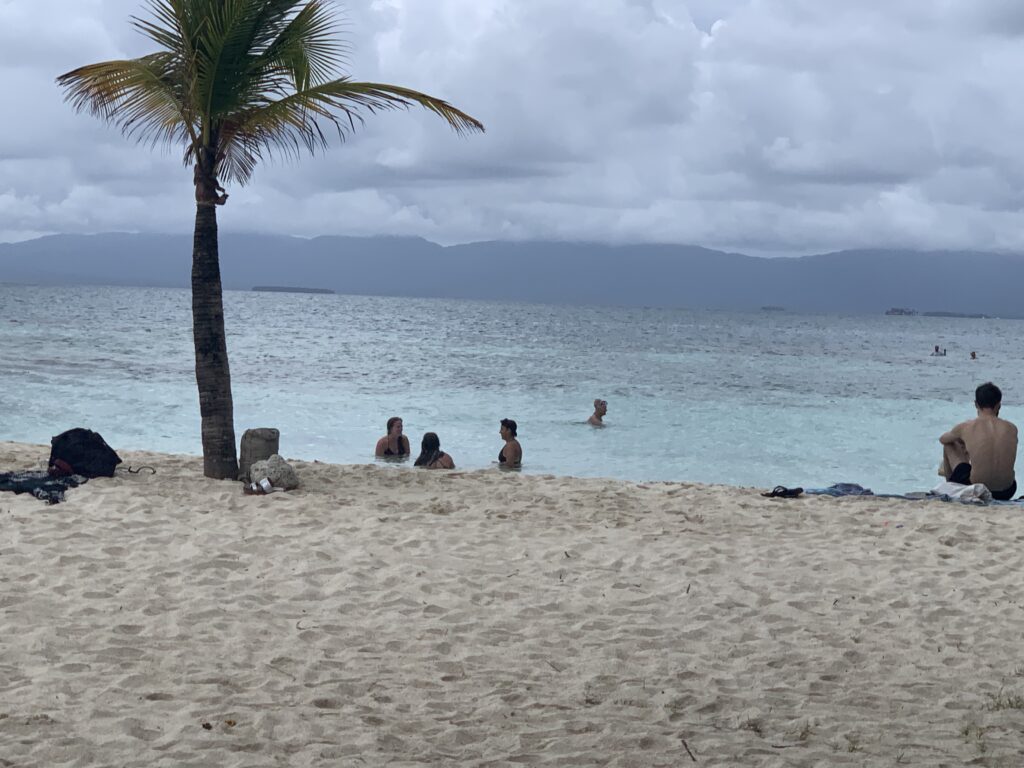
Swimming 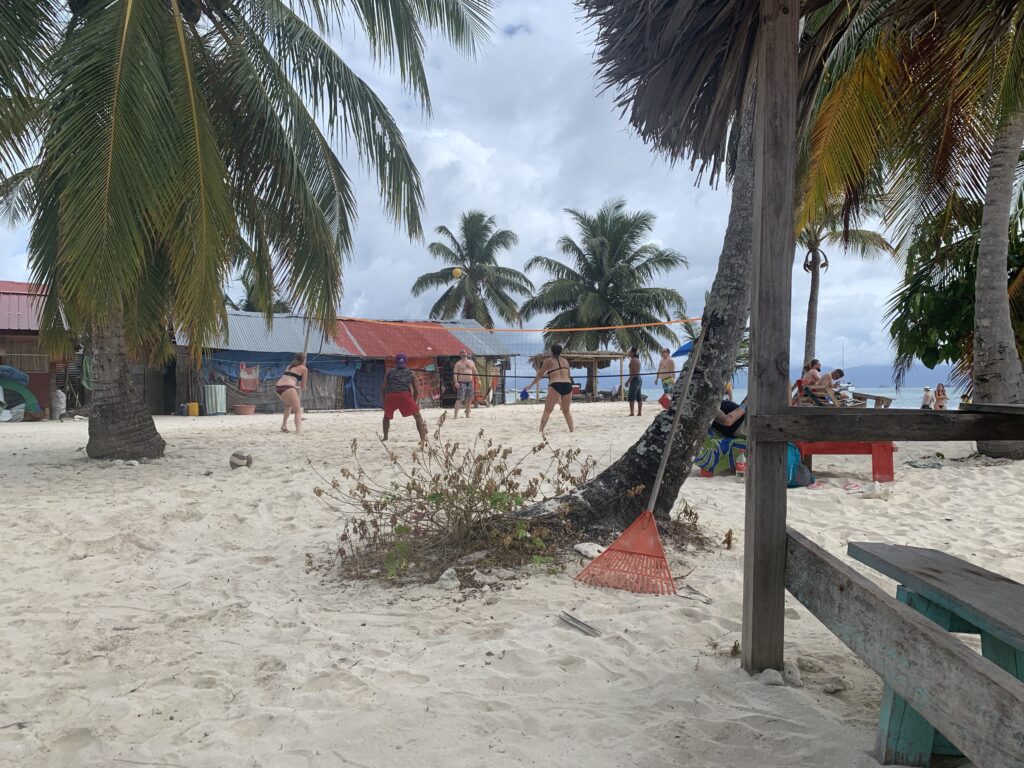
Beach volleyball 
Thank you in many languages 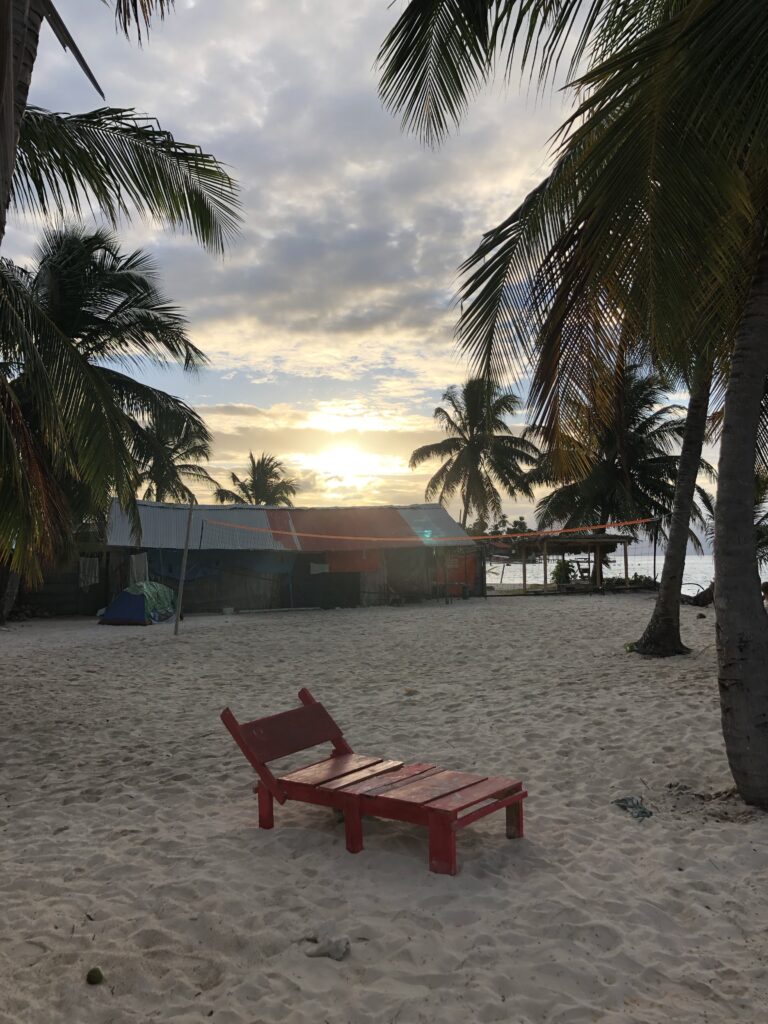
Snorkeling: As I have reported before, Bob and I are not really beach people, yet we love the ocean. This proved true once again, as, exhausted from the early morning and difficult ride, Heidi crashed out in a highly uncomfortable beach chair (see red chair above), and I put on my snorkeling gear to explore the sea. The reef wasn’t necessarily teaming with fish, but a wide variety of beautiful creatures, from blue-headed wrasses, blue tangs, rainbow parrotfish, yellow-tailed jacks, and a couple of dozen or so other species did show themselves off.
The following day, El Capitan and his crew, including a young man with a brownish dyed mullet that for some reason reminded me of a raccoon, took us to Perro Grande (Big Dog) Island for snorkeling. It was spectacular. Part of me is sad that our underwater camera wasn’t working, but part of me is also learning to enjoy the experience without necessarily recording everything in a photograph. Using words, I will share this experience.
This reef was quite varied, with brain corals, staghorn and elk horn corals, and half a dozen other shapes and varieties that I haven’t yet learned. The sea was a bit stirred up still from all the wind, and I was looking toward a murky place thinking, “I wonder what’s there.” Swimming toward it, I was suddenly face to face with a stingray that was about 3 feet in diameter. I quickly called Bob over, and it watched us for a few minutes before heading back into the depths.
Later, when swimming back toward shore to get a drink of water, I came across a cuttlefish, my first-ever, real-life encounter with one. Between six and eight inches long and translucent with green eyes, it put on quite a show. So, in honor of our friend Lauren Partin, who has a weird obsession with cuttlefish, I spent several minutes watching it swim forward and then backward, and then forward and then backward, although I’m not sure, for it, which direction was which. Finally, still thirsty, I continued toward shore when an entire family of cuttlefish lined up in front of me. This sounds weird, but it’s true: A dozen cuttlefish (I counted) ranging from an inch to about six inches in length, translucent with blue and red, lined up by height swam in a line right in front of me. I laughed. They probably laughed, and we all went on our way.
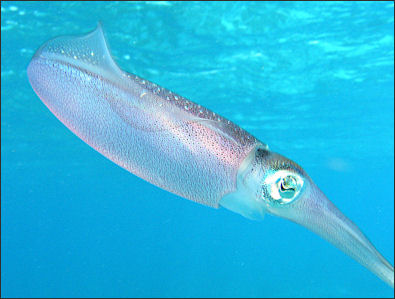
Later, back at Devil’s Island, I went back to territory I’d covered the day before. Head toward the buoy, follow the reef to the huge purple coral fan, turn right and swim to the sandy canyon to see the gigantic rainbow parrotfish munching on coral. Along the way, a school of about 200 black fish, about three inches long, came by and invited me to follow them. After several minutes, a school of about thirty electric blue tangs, swimming the opposite direction and with a trumpetfish smack dab in their center, invited me to follow along with them while they danced in and out of coral formations, played chase, and changed from light blue to black and back, depending on the lighting conditions. It was magical.
Over three days of snorkeling at three different islands, I can say the state of the reefs is pretty good. Some around Devil’s Island have clearly been hit by boats, and a few have some bleaching. Overall, though, the Guna’s reliance on fish has them working to protect their reefs, and most of the folks who make their way to this remote location have an appreciation for the ecology and are doing what they can to preserve it.
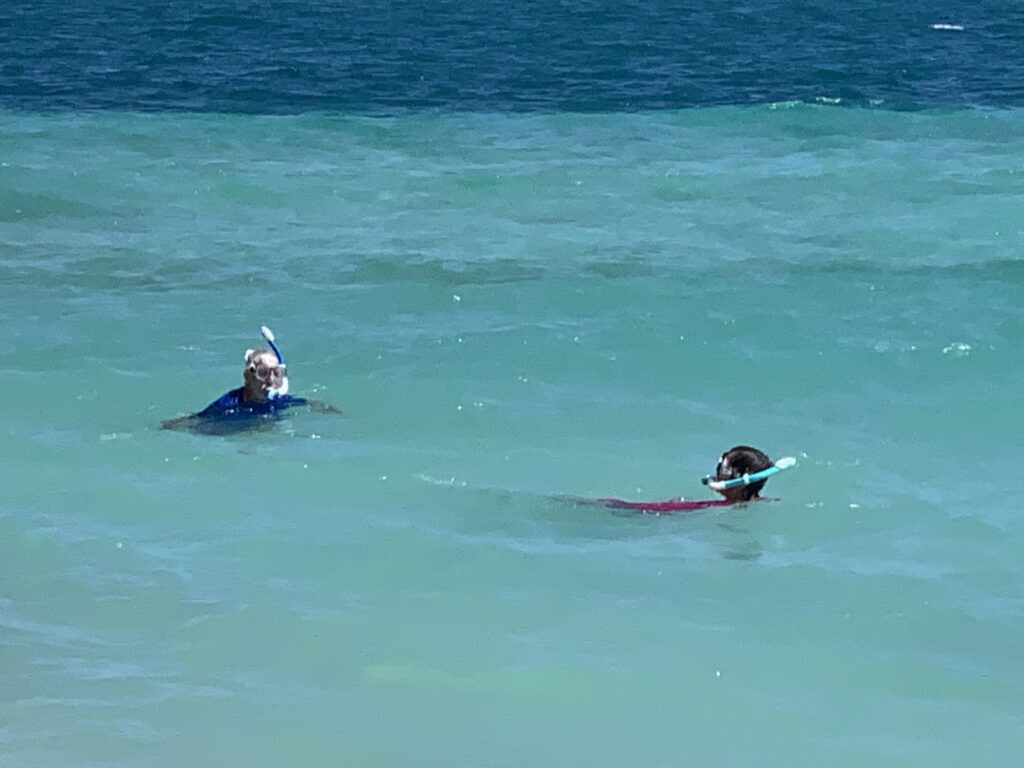
Bob and I snorkeling 
Me sad because I’m finished snorkeling
Food: Speaking of fish, it’s what for dinner among the Guna. Our choices, included in our tour package, for lunch and dinner were seafood stew, fish filet, whole fish, or chicken. The choices for sides were rice, potatoes, or patacones, a traditional Panamanian food of smashed, fried plantains. It was all quite tasty, and the portions were huge. When I, the vegetarian, had more than my share of fish, I got extra ensalada (salad) and a potato with my arroz (rice) or patacones. Interestingly, the salad was made with cabbage instead of lettuce, which doesn’t last long in a tropical environmental. Delish!
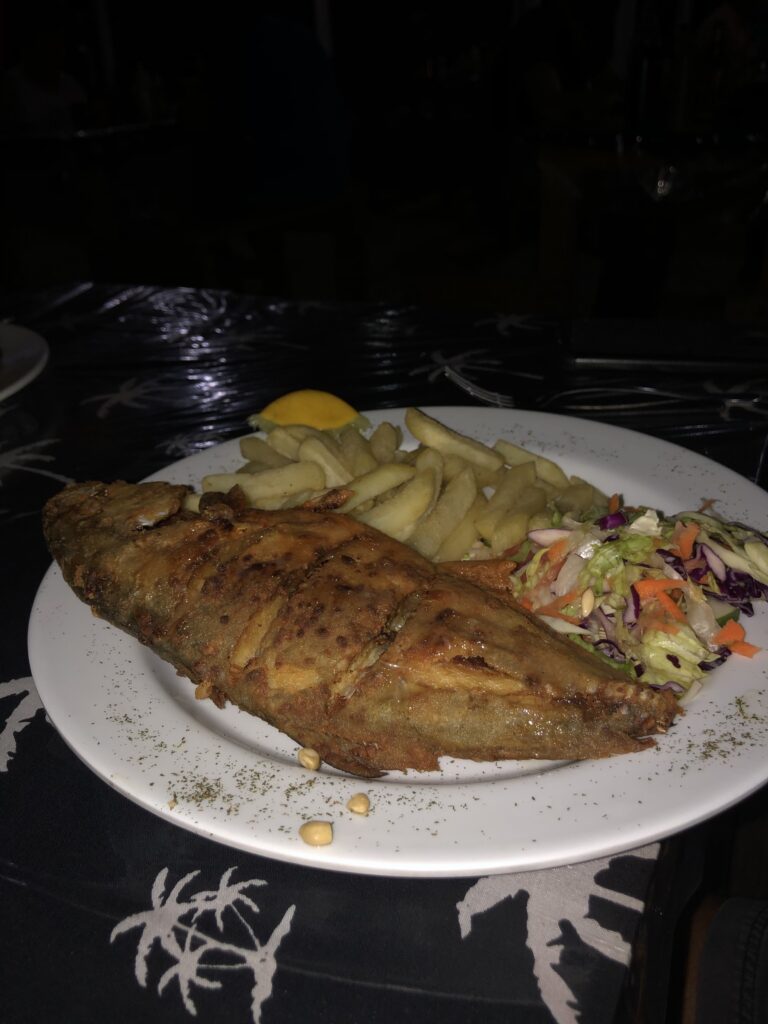
Fish 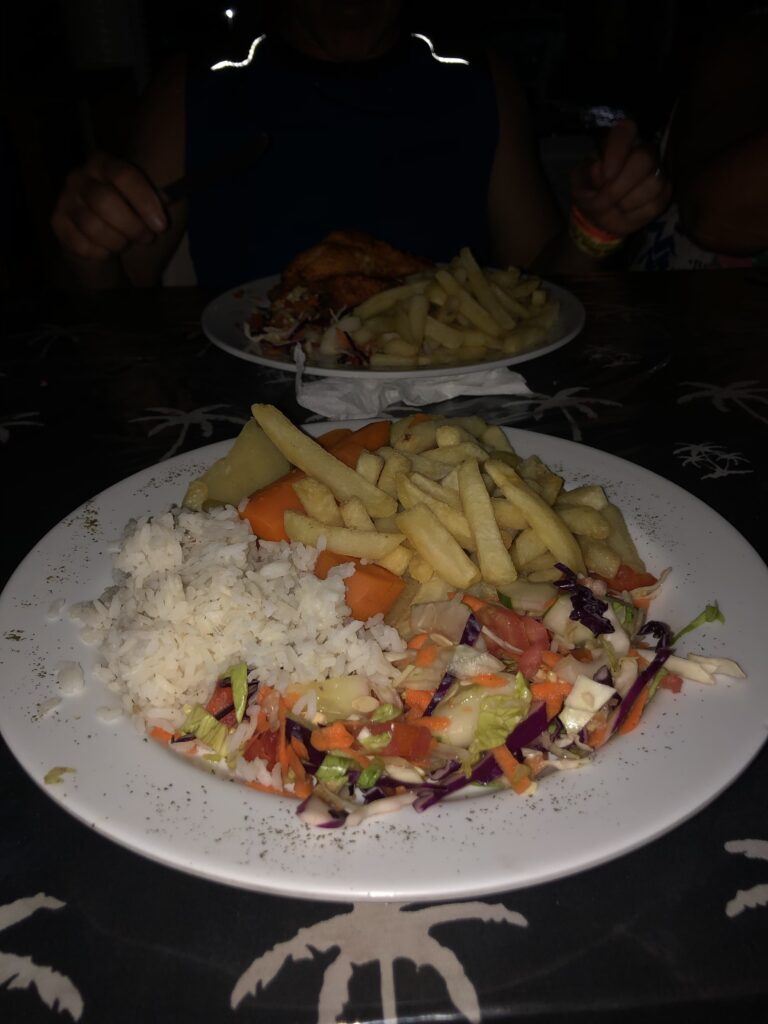
Vegetarian option (carbs!) 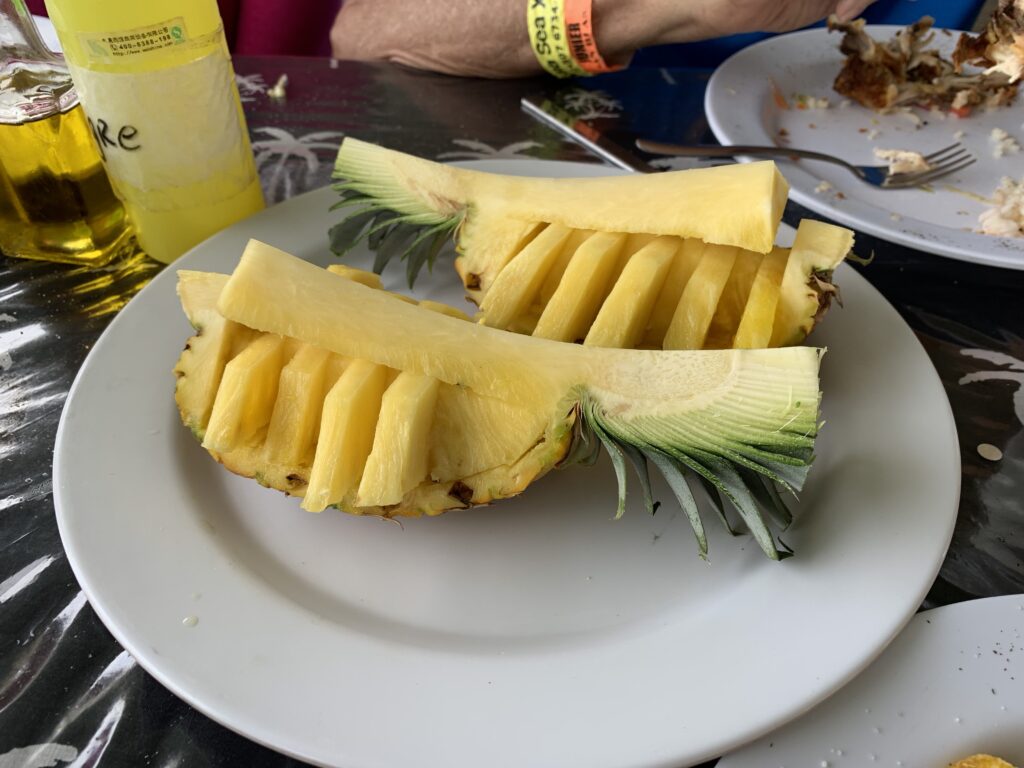
Dessert on day 2. Yum!
Coconuts were $2 each. After we drank the fresh coconut water out with of a straw (still working on some ecological issues), the hosts would machete the shell and hand over the delectable meat.
Our second night’s dinner was over the top. Mr. Denis, the family patriarch and entrepreneur, asked us if we’d be interested in a lobster dinner for an additional $50 (that’s total, so $12.50 each). We thought, why not? Mr. Denis went out that day and caught a huge lobster using a hook. The kitchen chef out-did himself, with fresh vegetables in addition to all the usual sides. We had a luscious and spectacular meal! Simon and Bob got up to their elbows in lobster juices, and we didn’t leave much behind. In spite of what the website warned, that was 5-star service!
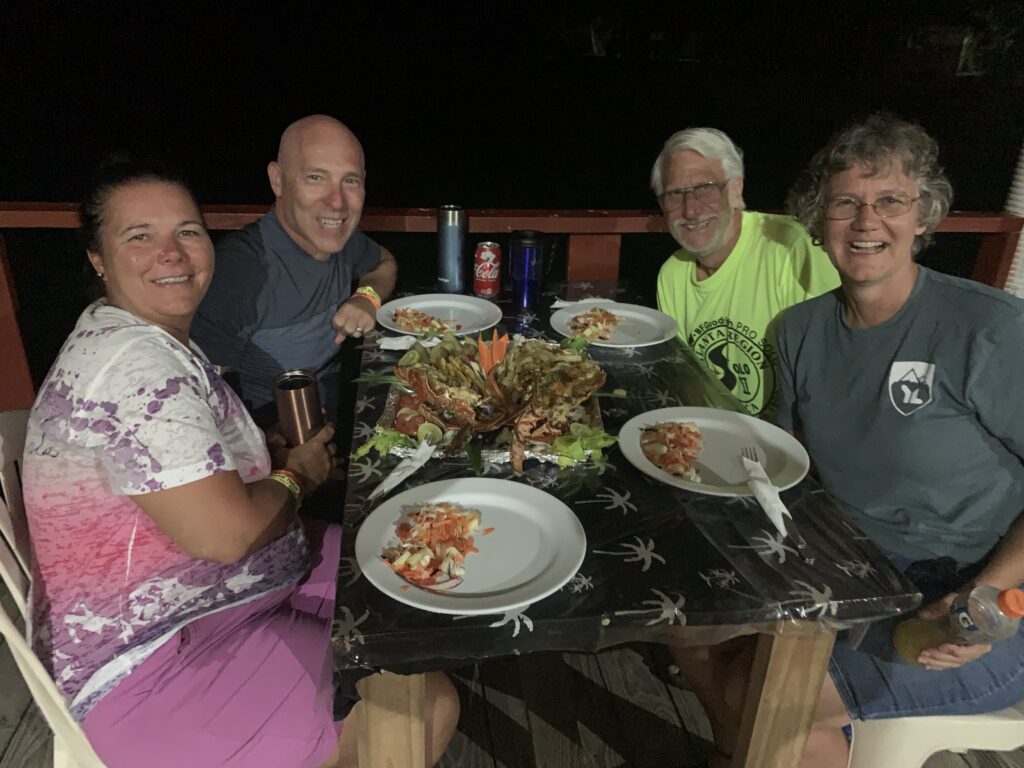
We are excited about our meal. 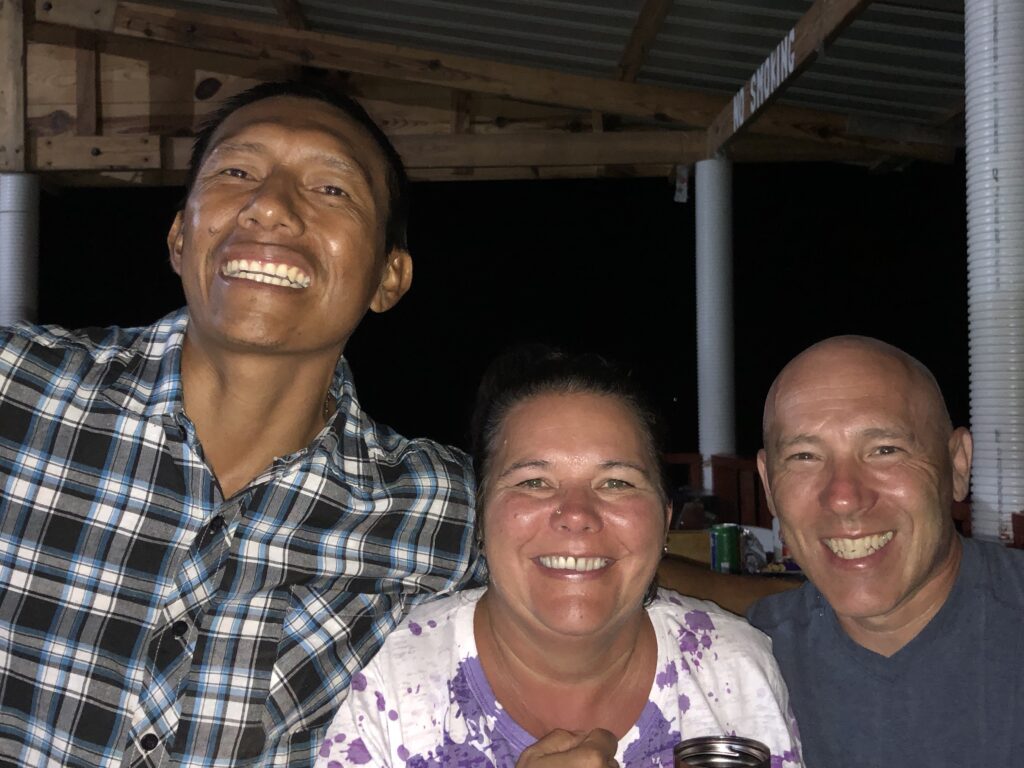
Mr. Dennis with Heidi and Simon
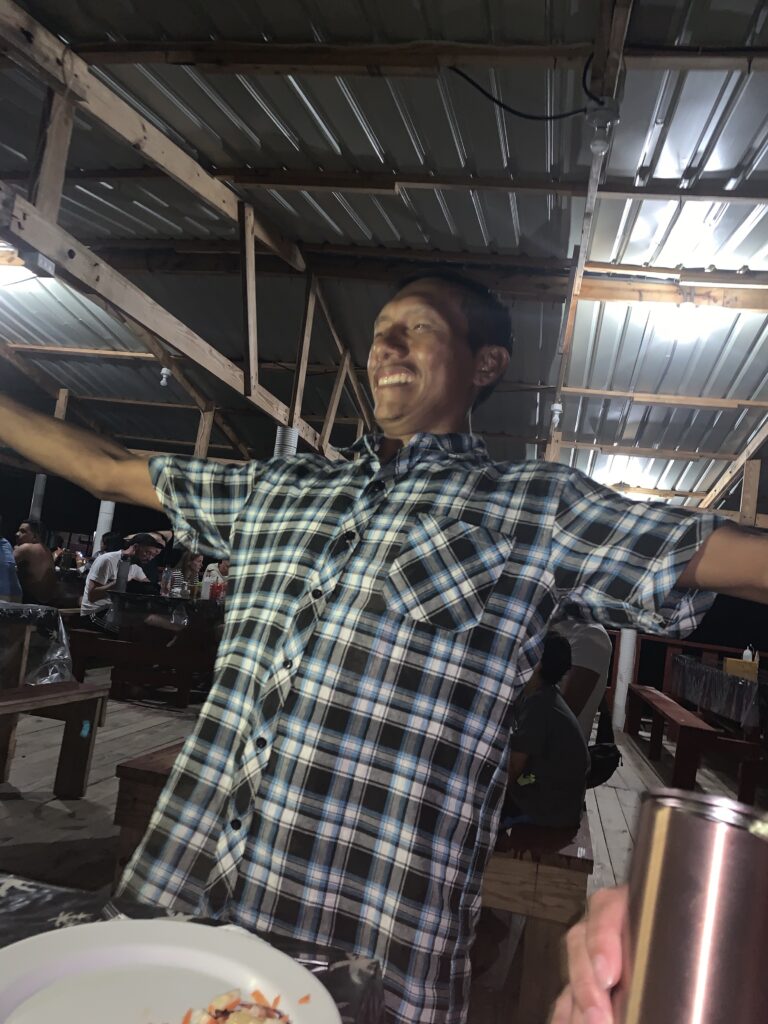
Mr. Dennis, Lobsterman 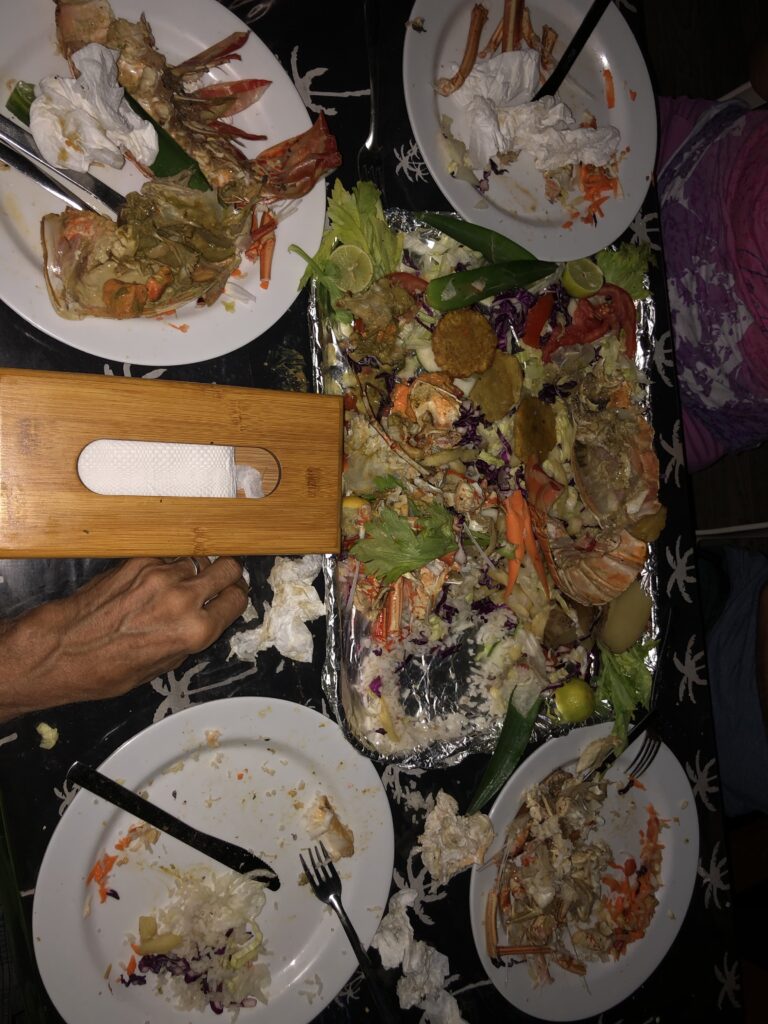
We ate a lot of food! 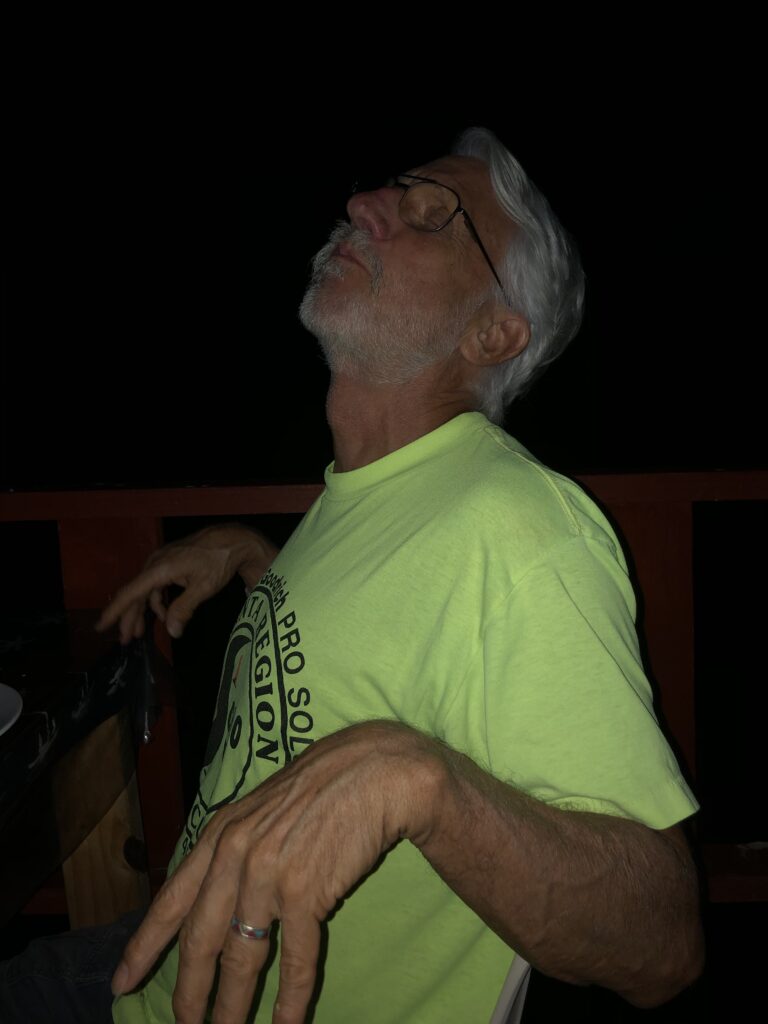
Bob in an after-lobster trance 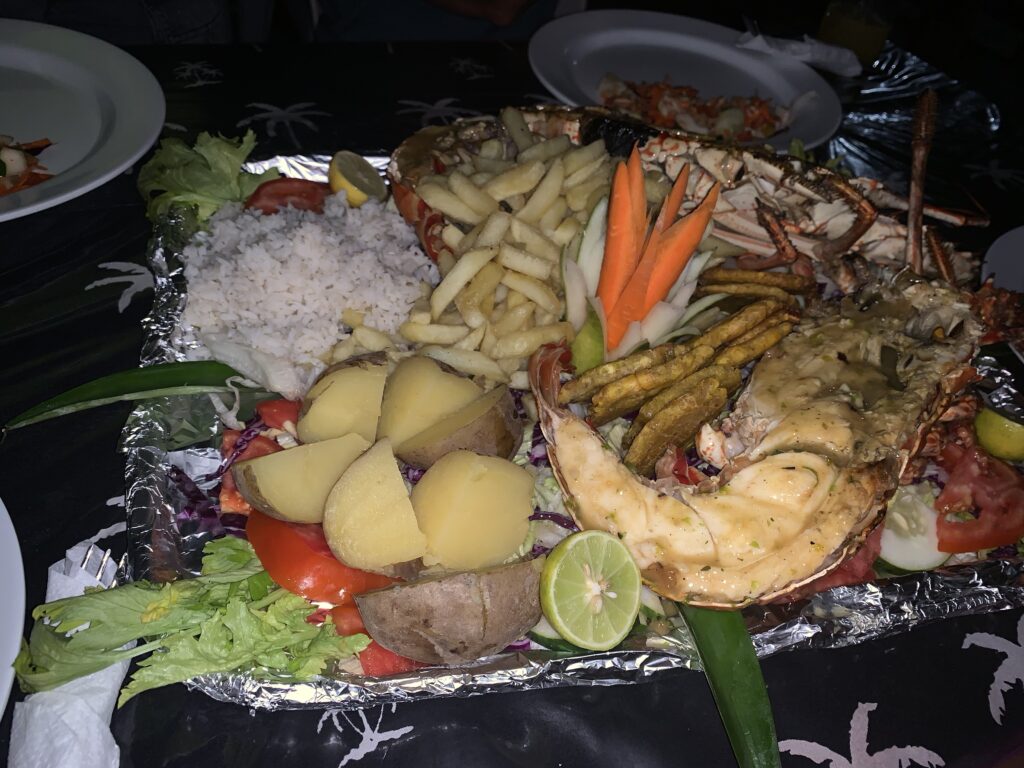
Before 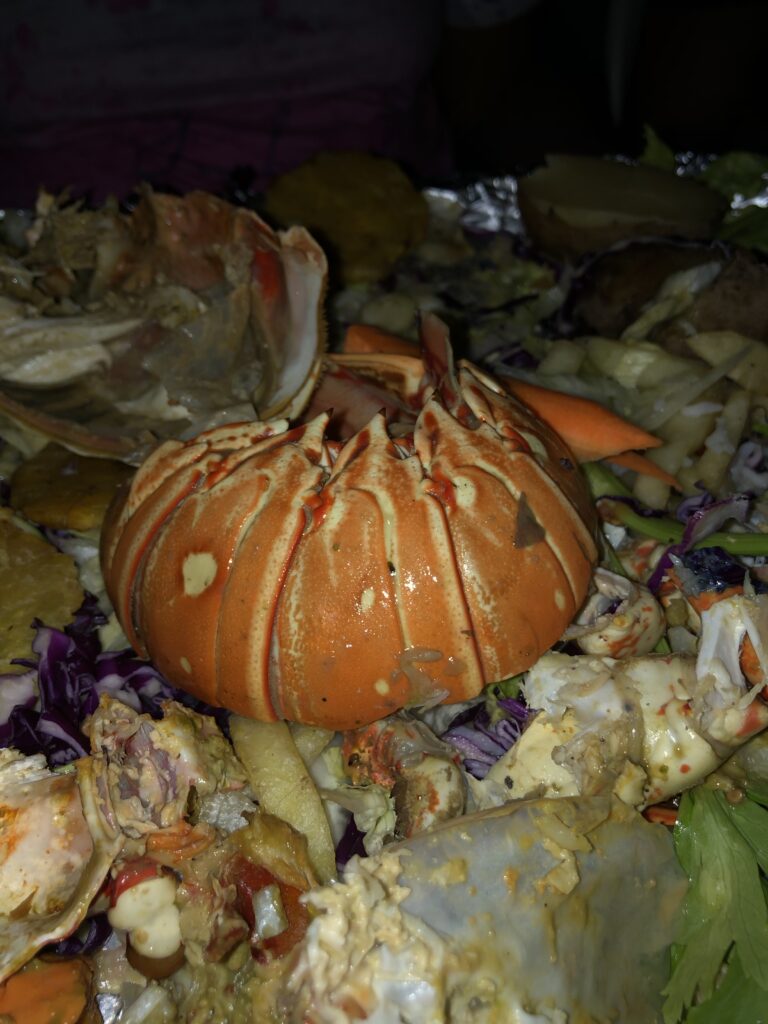
After
Accommodations: We were told ahead of time that accommodations were rustic. Our wooden cabin had two beds, mattresses on homemade wooden frames, mosquito netting, and a lightbulb. We had a deck with two plastic chairs and a wooden bench, but we could and did rent two more plastic chairs ($10 per day) from Mr. Denis. The views could not be beat.
Of the five cabins in our little area of the island, three had thatch roofs. Ours and the one on the other end had tin roofs, and we had a solar panel to power our lightbulb. That was cool!
Simon used a rock to hammer some loose nails, and Bob sprayed insect repellent around the door to scare away the busy ants. The contours of the island kept the sea breeze from blowing through our windows, so it did get pretty warm at night. All in all, though, it wasn’t bad. The bathrooms were generally clean expect for the sand. It was very much like camping, and we all fell in with the spirit of the place.

Our cabana 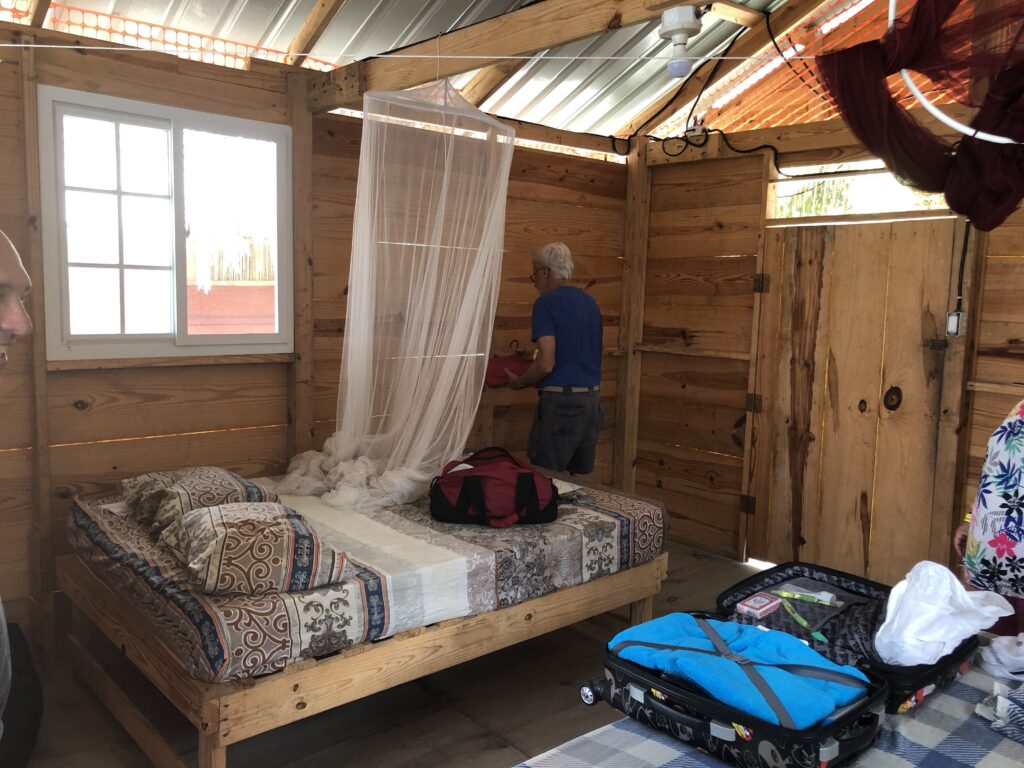
Interior 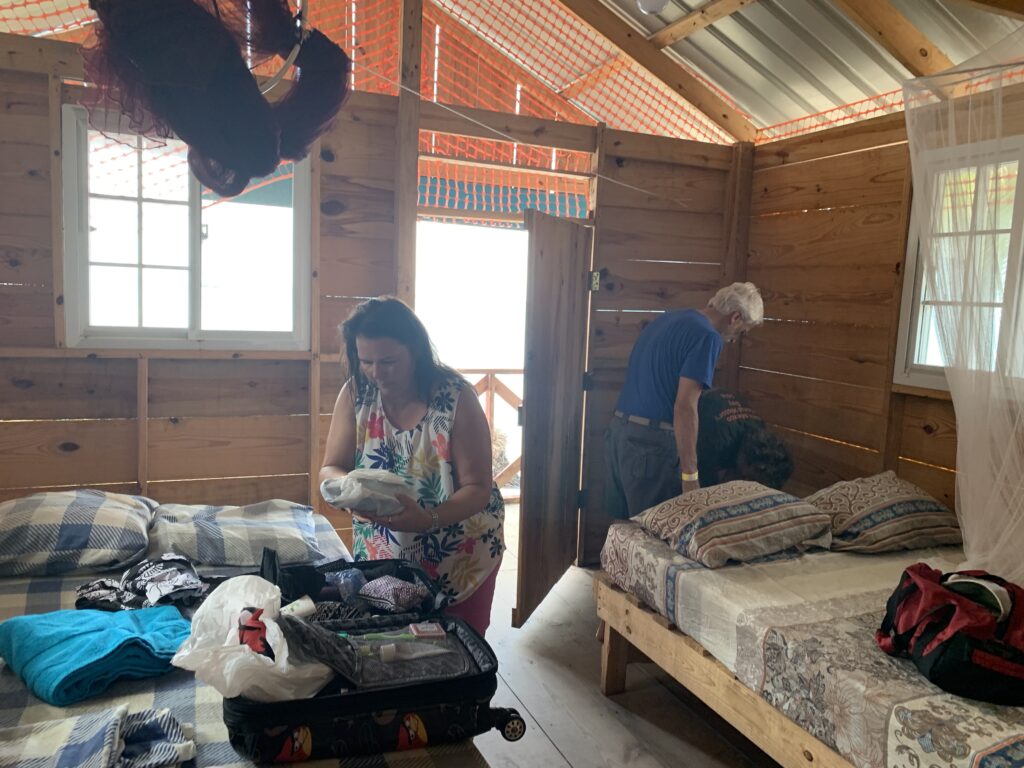
Unpacking 
View from the porch
Guna Yala History: For hundreds of years, the Guna (formerly Kuna) have lived on the Caribbean coast, inhabiting the islands of archipelago to avoid mainland bugs, fishing, and living traditional, subsistence lives. I haven’t yet researched their interactions with the Spanish, but it seems they were fairly autonomous during the colonial period. In 1925, fed up with the Panamanians trying to impose Hispanic traditions on them, they kicked out the national police and held a revolution. Since then, they have been in charge of themselves.
A right of puberty for a Guna woman is to have the septum of her nose pierced and to wear a gold nose ring. The women also wear traditional molas, specially embroidered cloth panels for their tops and skirts. The more intricate the stiches, the more prestigious they are. The women always wear a head scarf, and their legs are covered in elaborate “stockings” made from wound beads. I asked one of the grandmothers about it, and she agreed, “mucho trabajo” (a lot of work)!

Traditional Guna woman on a cell phone 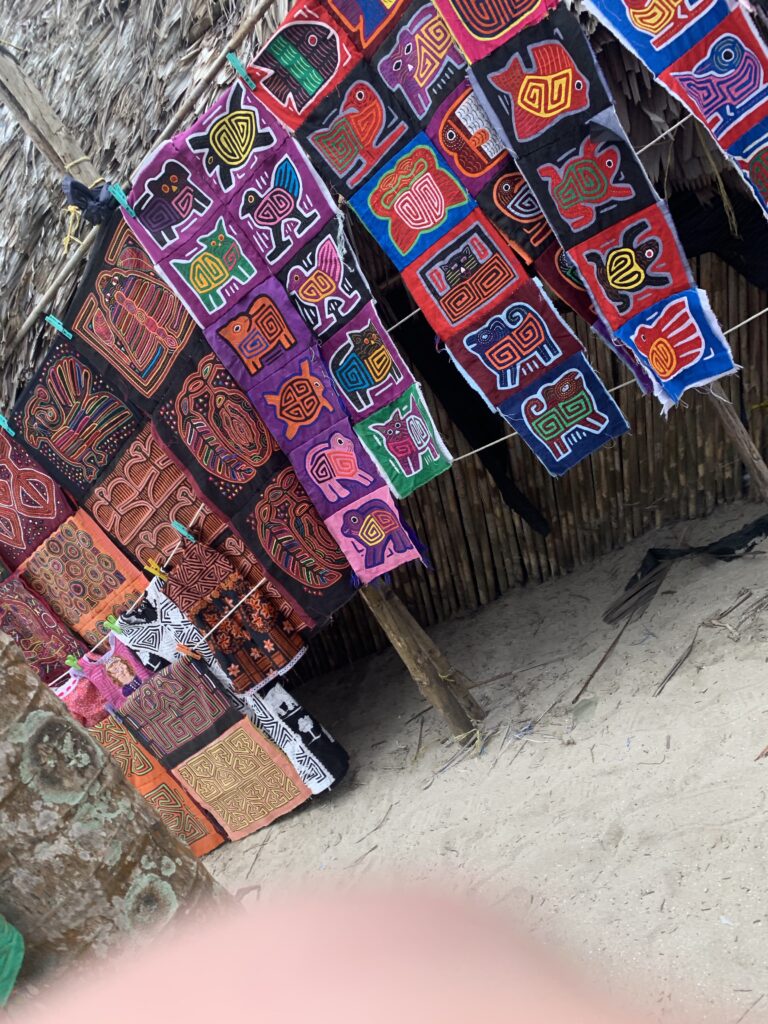
Colorful molas
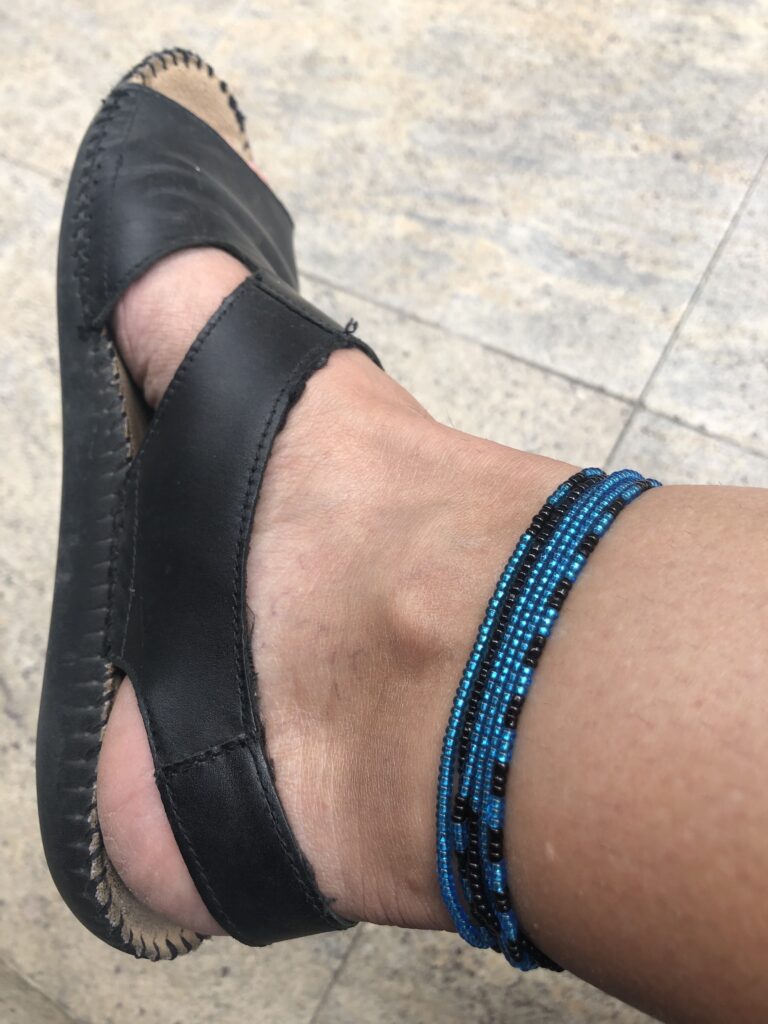
This ankle bracelet, the colors of my favorite fish, is a small sample of what traditional Guna women use to wrap all the way up their calves with intricate bead patterns. 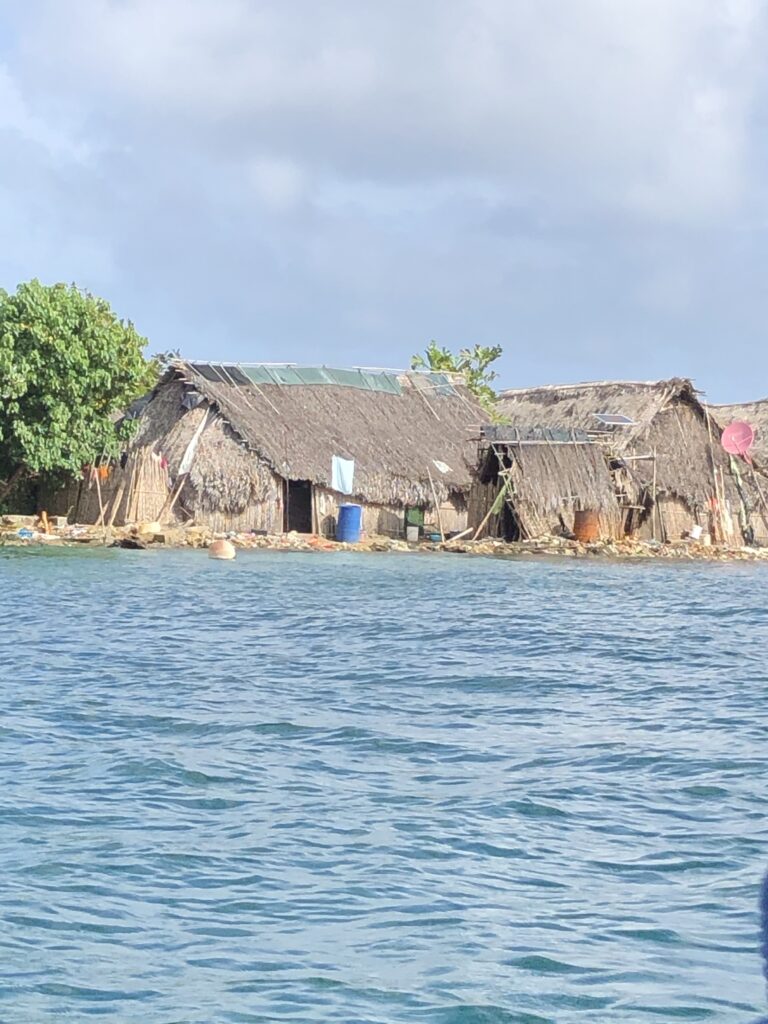
Traditional Guna island village

Island “ownership”: From all that I have read and come to understand by visiting with Mr. Denis and others who were staying on the island, the islands belong to all of the people. Caretakers, such as Mr. Denis and his family, watch over and run everything on a rotating basis. How long the rotations last, how the caretakers are chosen, and what they earn for their efforts, remain a mystery. (Mr. Denis did offer to sell the half of the island he overseas to Simon when Simon teased that we had decided to stay for six months.)
One interesting conversation a friend had with the caretaker of the other half of Devil’s Island is whether the Guna really want tourism at all. They struggle to deal with the trash generated by tourists and are beginning to suffer from overfishing. Is the money tourists bring in worth the costs? What purpose does the money serve to a people who were perfectly content living in what the rest of the world considers a paradise? On the other hand, go-getter entrepreneurs like Mr. Denis need an outlet. It’s a tough call, but I’m glad I did get to experience what they offer to the outside world.
Other Miscellaneous Observations and Notes:
- Few things—maybe a howitzer or a parent stepping on a Lego—are louder than a coconut falling from a tree and hitting a tin roof. Especially if, say, one is using the bathroom, and the coconut falls on that roof.
- One day we visited a “natural swimming pool,” an underwater sandbar in the middle where starfish like to congregate. That was fun.

- A big project that looked like the makings of a resort sat rotting in the jungle on our way to the comarca. Teo explained using only Spanish that it had been funded by the Venezuelans, and, with sanctions imposed by the United States, came to a screeching halt. Who knows when or if it will ever be complete.
- All of the family works on the island. From cooking to raking sand, washing sheets by hand to cleaning the bathrooms, everyone in the family is busy for some portion of the day. The youngest boy, probably 3, spent part of his morning picking up fallen coconuts and putting them in a wheelbarrow. (Afterwards he got a ride in the wheelbarrow from big brother, and you could tell from his huge grin that the work made it worthwhile.) Depending on their age, they also spend part of the day resting in hammocks in their tin shack, playing beach volleyball with the tourists, or running the family craft store.
- The boat ran out of gas on our way back to the port! Thankfully, not too far away, another boat was puttering between some of the islands. Our mates hailed the captain who came over and gave us a gallon. Then we stopped by the “gasoline store,” a dock in one of the traditional island villages piled high with plastic containers (presumably full of fuel), topped off with gasoline poured through the top half of a bleach bottle, and headed on in.
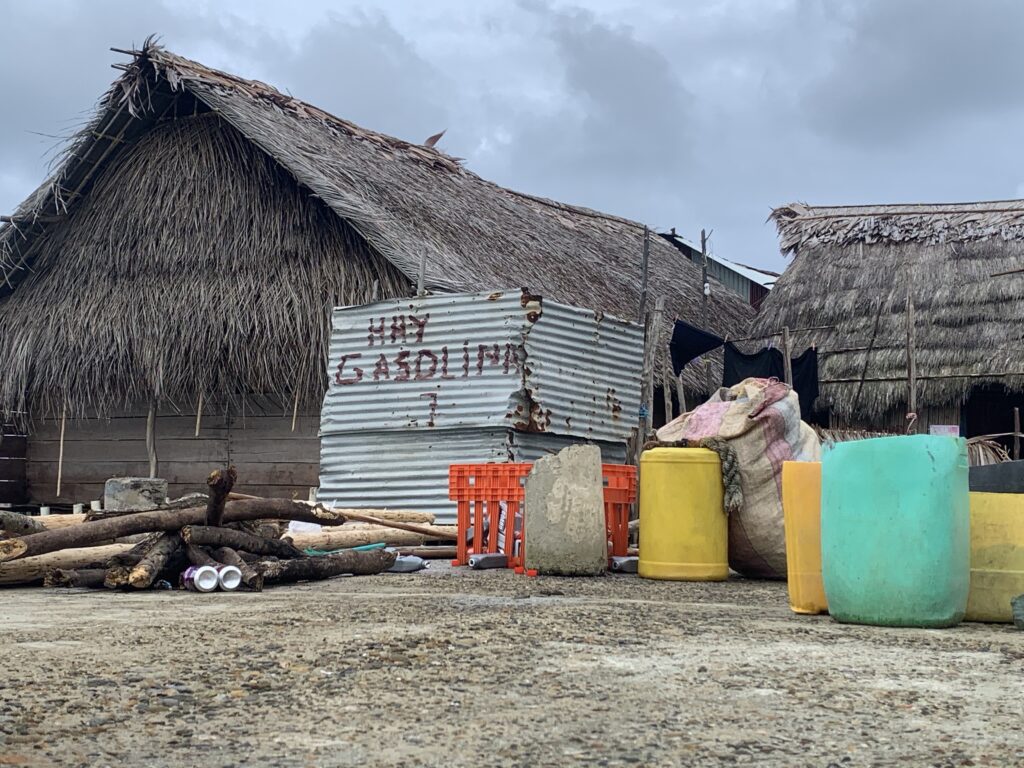
It was an adventuresome end to an awesome adventure.
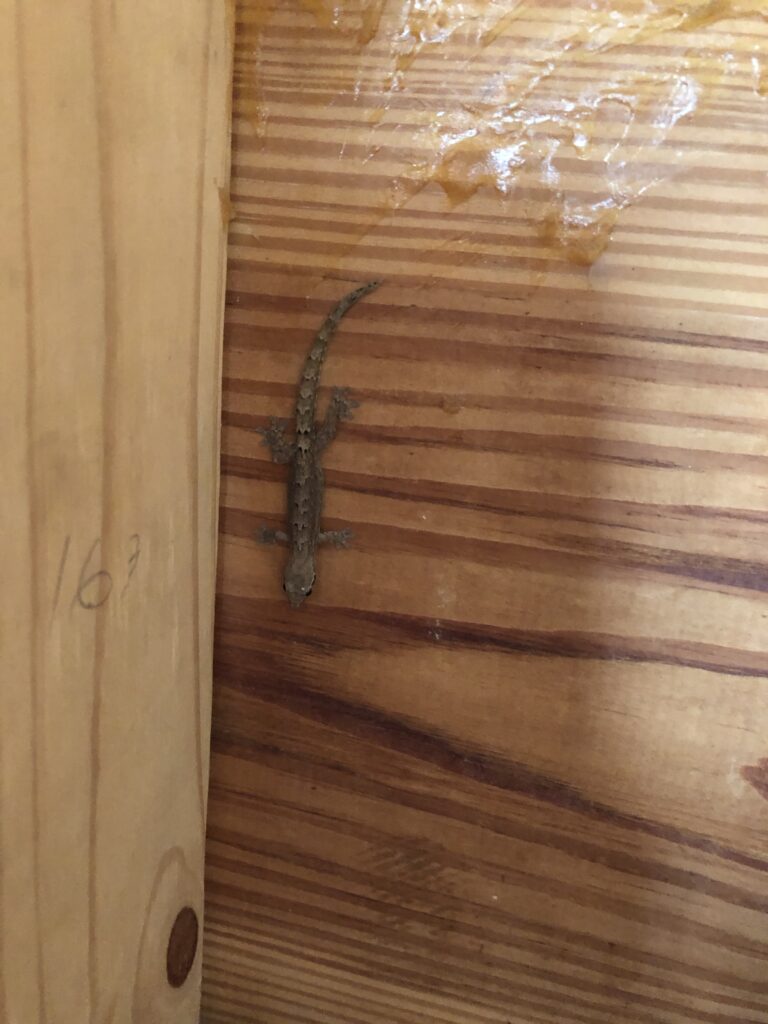
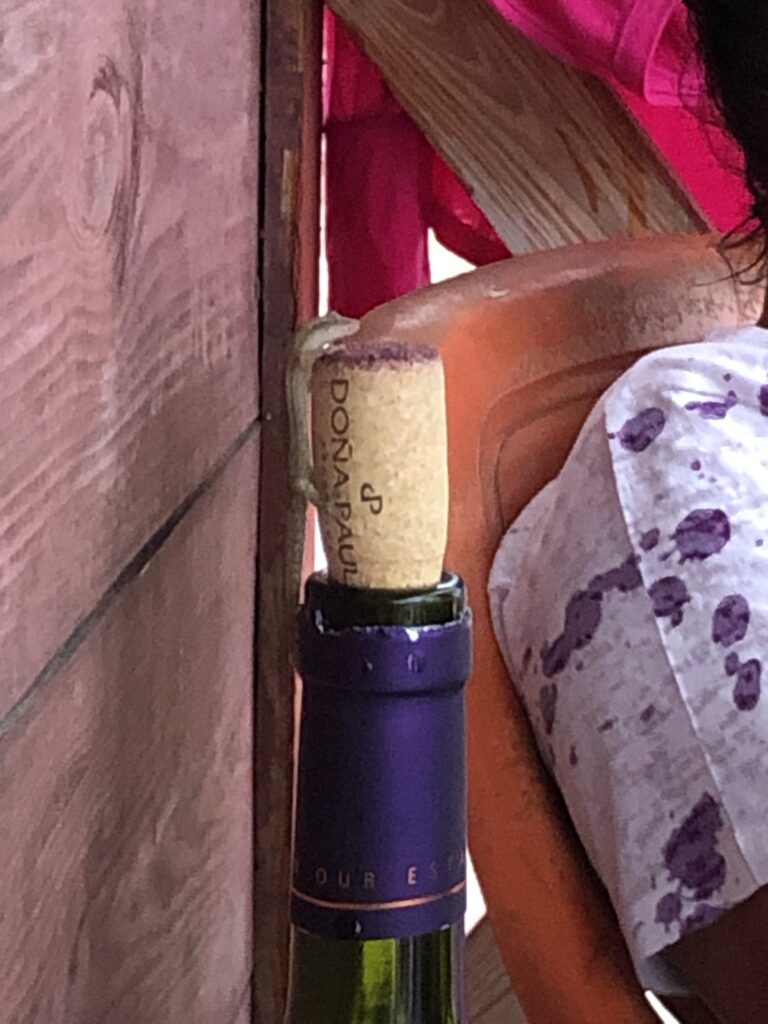
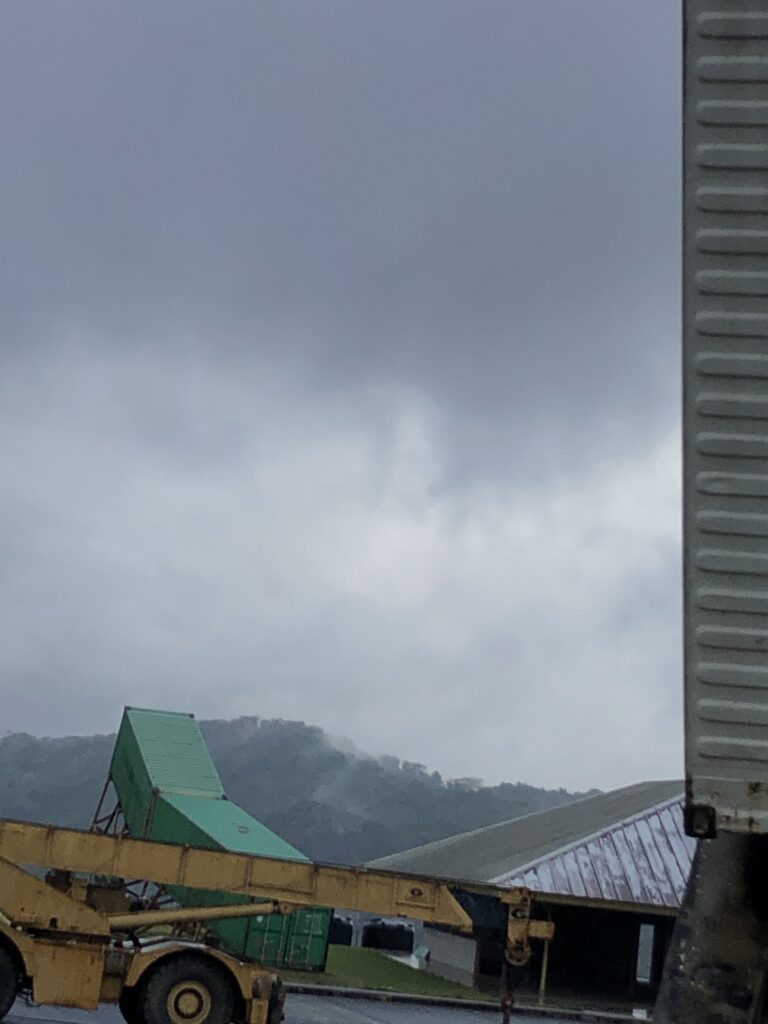
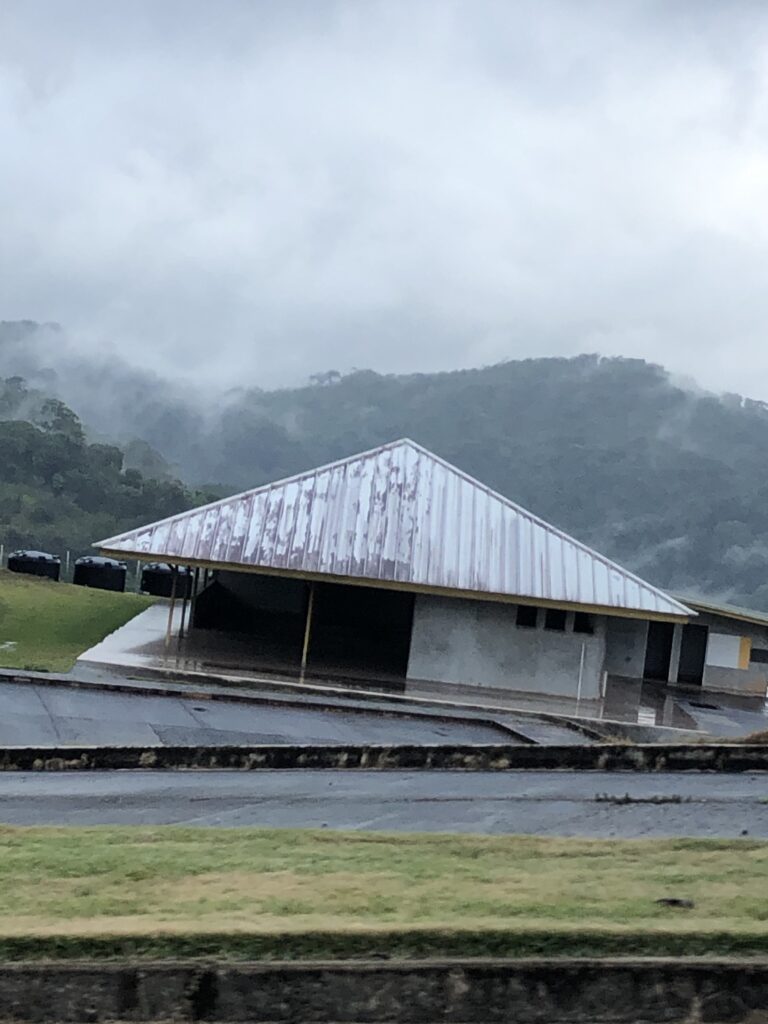


This is fantastic! I enjoyed being with you on this adventure as you described everything so beautifully. All the pictures are beautiful and informative also.
Thank you! Getting there is not easy, but it’s a lovely, lovely place.